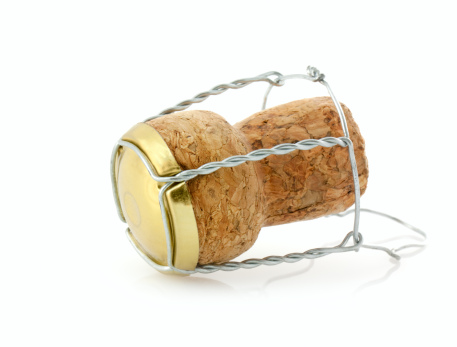 Champagne is a staple at weddings, New Year’s Eve, birthdays, and more. Everyone’s favorite moment is when the bottle is opened and you hear the distinctive “pop” as the pressure is released from the bottle. Throughout the revelry, people easily overlook the champagne cork, which has the important job of keeping champagne in prime condition. Here’s some fascinating history of champagne corks.
Champagne is a staple at weddings, New Year’s Eve, birthdays, and more. Everyone’s favorite moment is when the bottle is opened and you hear the distinctive “pop” as the pressure is released from the bottle. Throughout the revelry, people easily overlook the champagne cork, which has the important job of keeping champagne in prime condition. Here’s some fascinating history of champagne corks.
Bottle stoppers made of cork have a long history. Some evidence suggests that the ancient Greeks and Romans used cork to seal bottles hundreds of years ago. Cork became popular again in the late 1500s and was used as a replacement for expensive glass stoppers. In the 1630s a British man came up with the idea of securing corks by wrapping them in string, functioning in a similar way to modern day champagne cages. However, Dom Pérignon, French monk and namesake of the high-end champagne brand, is credited with improving the cork and string method so that champagne bottles were less likely to explode and cause injury.
Creating the corkMany people may not realize that cork comes from a tree that is commonly grown in Southwestern Europe and Northwestern Africa. To create corks, strips of material are carefully removed from the tree and hung to dry for about 6 months. Next, the strips are boiled then dried for several more weeks. When this process is complete, the cork is cut into the appropriate shape to seal bottles. In the past, corks were cut with tapered sides to make them easier to insert. Modern bottling systems have made tapered sides necessary; corks are now cut with straight sides that can be compressed and inserted. Interestingly, champagne corks only develop their distinctive mushroom shape after being forced into the bottle and subjected to the pressure created by the champagne. They’re only inserted about 2/3 of the way into the bottle, then the top is secured with the cage.
Why cork?Cork is the material of choice for champagne and wine bottles for several reasons. Part of the reason for using corks is simply tradition. Although other materials have been developed that can replace cork, many vintners and wine enthusiasts still love to see that cork in the bottle. More importantly, cork helps facilitate the aging process of wine and prevents spoiling. Well-made corks allow approximately one milligram of oxygen into the bottle per year. This allows the wine to develop the proper flavor without leading to oxidization, which can spoil the wine.
Enjoying champagneTo ensure the perfect bubbly experience, place your bottle in the fridge for several hours to chill prior to drinking. You can also use the ice-bucket method by filling a bucket with equal parts ice and water, then adding the bottle for 20 minutes. Once the champagne has chilled, rotate the tab on the cage about six times to loosen it, but don’t remove the cage yet. Firmly, grasp the cage and the cork together, tilt the bottle at a 45-degree angle, then begin to rotate the bottle. This loosens the cork slowly and allows the pressure to escape gradually. Keep firm pressure on the cork as you feel it begin to push out of the bottle. Once you hear the fizzing sound of escaping gas, you’ll be ready to drink! If done properly, opening the bottle this way will eliminate the loud “pop” and reduce the chance of spilling.
The magical champagne cork has an important job and a fascinating history. Next time you break out the bubbly, you’ll be able to tell your friends about the importance of that little cork.
Advertisements Share this:




